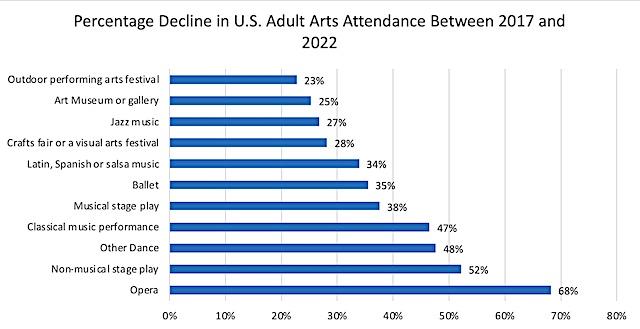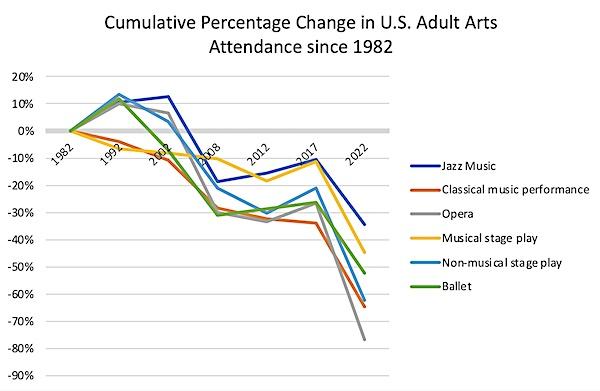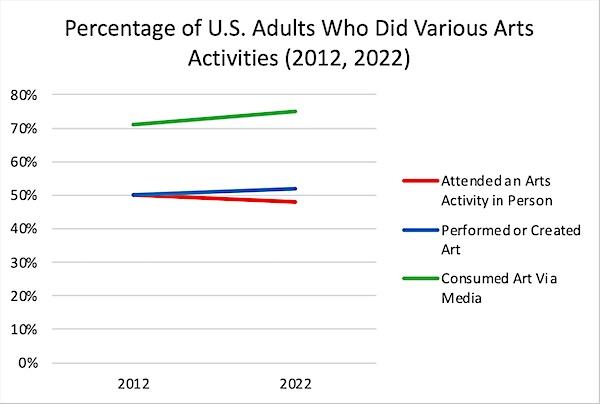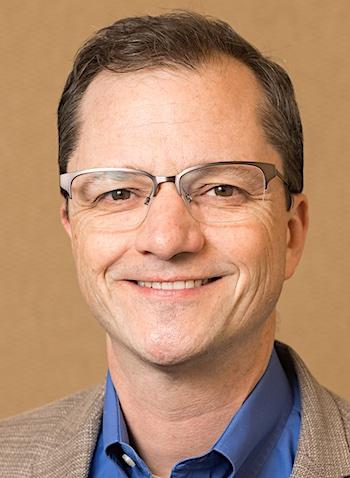Photo by Joseph Mark
By Andrew Recinos, President & CEO, Tessitura
One should gravely view the overall declines in visual and performing arts attendance.” – Preface from Arts Participation Patterns in 2022
Every five years since 1982, the National Endowment for the Arts, in conjunction with the U.S. Census Bureau, has asked Americans how the arts intersect with their lives through the Survey of Public Participation in the Arts (SPPA). Released last year, the 2022 SPPA shows steep declines in attendance across nearly all art forms over the past five years:

From Survey of Public Participation in the Arts, 2022
While these figures are bracing, it is important to note that the 2022 SPPA reflects arts participation between July 2021 and July 2022, a time when the COVID-19 pandemic still had an outsized impact on the sector. More recent data from other sources (1) suggest some improvement in attendance as the pandemic has receded.
Still, even if the 2022 data turns out to be overly bleak, SPPA data back to 1982 shows a consistent, multi-decade decline in American arts audiences:

Selected Artforms, Data from Survey of Public Participation in the Arts, 1982 – 2022
While the numbers speak for themselves, I believe that there are reasons for optimism.
In my role as president & CEO of Tessitura, a nonprofit technology community serving the arts and culture sector, I am fortunate to work with hundreds of arts organizations of various sizes and genres across the United States. For more than two decades, I’ve worked with arts leaders and their teams as they navigate the ongoing challenges seen in the SPPA data.
The struggles that arts professionals face are very real and the attendance trends found in the SPPA are indisputable.
Still, I periodically meet with arts organizations and leaders who buck the SPPA trends and increase participation. I call these organizations Trend Busters.
What do Trend Buster organizations have in common?
Trend Busters don’t fit into any obvious categories. They are of varying budget sizes, artistic disciplines, financial models, and geographies. However, I have found some common themes to explain what makes these organizations zig while the larger sector zags.
A large part of the answer comes down to the formula made famous by arts leader and educator, Michael Kaiser: steadfast leadership, exciting programming, and an engaged “family” of supporters.
In addition, I have observed another consistent Trend Buster trait: an unwavering understanding of who they aim to be and who they aim to serve. Trend Busters don’t just have a mission, they wring out every word of their mission. They don’t just have audiences they aim to serve, they are deliberate about finding and delighting those audiences.
Where the SPPA shows consistent decreases in audiences, Trend Buster organizations show consistent increases. How do they do it?
Two Trend Busting Philosophies to Increase Participation
When it comes to finding and delighting audiences, I have found the Trend Busters fall into two participation philosophies: a Go Broad approach and a Go Deep approach.
Go Broad organizations define their product narrowly and their reach broadly. A string quartet with a national touring schedule would be a Go Broad organization. When the Dallas Black Dance Theatre seized the opportunity to add a digital program to bring their work to a global audience during the COVID-19 pandemic, they were using a Go Broad tactic. When they continued paid digital programs, student programs, and digital subscriptions long after other ballet companies stopped COVID-era digital programming, they were leaning into a Go Broad strategy. Go Broad organizations often have words like “the widest possible audience” in their mission statements.
Go Deep organizations define their reach narrowly but their product broadly. A Go Deep organization looks for a deep, pervasive connection with a specific community. To accomplish this, rather than offering a single artistic product, a Go Deep organization may provide a wide variety of experiences. New York City’s Irish Arts Center has a mission of “building friendships and community through shared learning experiences,” which is accomplished through a wide variety of Irish arts and education programs. Their product is broadly defined as Irish arts and culture while their reach is narrowly defined to their home city. Go Deep organizations often feature “community” prominently in their mission statements.
While either can be very effective, I have found that Trend Busters intentionally chose one of these approaches and pursued their strategies accordingly.
Go Deep and Go Broad Strategies in the SPPA Data
If one focuses solely on in-person arts attendance, the SPPA is a very discouraging read. However, if one shines a light on other facets of the data, some interesting opportunities emerge. In fact, a close read of the SPPA shows data in support of both Go Broad and Go Deep strategies.

Data from Survey of Public Participation in the Arts, 2012 and 2022
One way I’ve seen Go Deep organizations engage their community is by offering opportunities to both attend and participate in their art. Now consider the SPPA data. While attendance at in-person arts events has declined over the past ten years, the percentage of Americans who performed or created art increased modestly over that time. An organization with a Go Deep philosophy might use this insight to support adding participatory experiences alongside their attendance activities.
Exploring the SPPA can also highlight a Go Broad strategy. While in-person attendance declined over the past ten years, consumption of arts via digital media far exceeds in-person attendance and has only increased—to 75 percent of all Americans as of 2022. Organizations with a Go Broad philosophy might use this data to consider (or reconsider) a digital delivery strategy.
Go Deep in Practice: Centering Local Community at Ballet Austin
“Our mission is to involve and strengthen our community through the creation and experience of dance and the encouragement of health and well-being.” – Ballet Austin Mission Statement
According to the SPPA, U.S. adult attendance at ballet performances has declined 52 percent since 1982. Undeterred, Ballet Austin has been consistently increasing participation and in its 2023-24 season had higher attendance than any time in their 66-year history. They are the definition of a Trend Buster.
It is instructive to look at the Ballet Austin mission statement. Dance, health, and well-being are prominent, but community comes first. By defining its reach narrowly (the Austin community) and its product broadly (dance, health, and well-being), Ballet Austin shows the hallmarks of a Go Deep approach.
Like many ballet companies, Ballet Austin centers its Go Deep strategy on the twin pillars of dance performance and youth dance education. Its Go Deep strategy doesn’t end there.
Beyond youth education, Ballet Austin’s Go Deep strategy led the organization, a few years ago, to start offering dance and fitness classes for adults as well. Today, its Butler Center for Dance and Fitness gives 60 adult classes per week and welcomes more than 11,000 participants each year. The success of this Go Deep strategy wouldn’t be a surprise to a student of the SPPA data. In 2017, while only 3 percent of American adults attended ballet performances, 24 percent of American adults danced.

Ballet Austin offers 60 adult classes per week, deepening connection with its community through participation. Photo by Anne Marie Bloodgood, courtesy of Ballet Austin
Ballet Austin’s broadly defined product, deeply focused on the Austin community, has created a virtuous cycle, where fitness participants routinely become audience members, many of whom become donors who fund community engagement activities—and on and on. The Go Deep strategy hasn’t just increased participation; it has strengthened the whole organization.
Most importantly, Ballet Austin’s Go Deep strategy is bringing dance, health, and well-being to more and more Austinites every year, contributing to the overall vitality of its hometown.
Go Broad in Practice: Reaching the Global Community at Detroit Symphony Orchestra
“The Detroit Symphony Orchestra impacts lives through the power of unforgettable musical experiences by sustaining a world class orchestra for our city and the global community.” – Detroit Symphony Orchestra Mission Statement.
Rarely does an American orchestra define its target audience as “the global community.” At the Detroit Symphony Orchestra (DSO), they truly live this “Go Broad” approach. In 2011, the DSO became the first American orchestra to offer an ongoing series of free livestream webcasts. With part of its goal to become “the most accessible orchestra on the planet,” the orchestra soon clocked more than a hundred thousand views from around the world as part of its Live from Orchestra Hall series.
In March 2020, when the COVID-19 pandemic shut down orchestras around the world, the DSO reached into its archive of nearly ten years of Live from Orchestra Hall recordings, paired them with online watch parties, and continued serving global audiences.
Today, while most arts organizations have wound down their digital programs, the DSO continues to invest in this activity. In addition to expanding Live from Orchestra Hall and providing 13 years of archived programs through DSO Replay, it offers recorded learning resources for children through DSO Classroom edition. Around the world, audiences now can experience the artistry of the DSO through its website, YouTube, Facebook Live, TV streaming platforms like Roku, and via its own DSO Live app.
With a Go Broad strategy, Detroit Symphony Orchestra has seen a virtuous cycle of engagement. Prior to the pandemic, it had built a global, digital audience. During the pandemic, their digital content helped the orchestra to build even more first-time digital visitors while remaining connected with existing audiences.
Today, this continuous delivery of symphonic music to Detroit and the world has helped the orchestra to bounce back: it has reported balanced budgets post-COVID, truly a trend-busting statistic in today’s arts world.
And viewership continues to grow. Last season, there were roughly 350,000 views of DSO webcasts. This is a truly impressive number in alignment with a data point in the SPPA: in 2022, while only 48 percent of Americans attended an arts event in person, 75 percent consumed art via digital media. By leaning into a “Go Broad” strategy that targets a global community, the DSO is not only benefiting financially, it is also fulfilling its goal to be the most accessible orchestra on the planet.
Takeaways: What does it take to become a Trend Buster?
Regardless of art form or budget size, some organizations thrive against the odds. Here are a few learnings from these Trend Busters:
Look beyond the discouraging statistics. While the SPPA paints a sobering picture of in-person arts attendance, its broader profile of arts participation points to several areas of opportunity. Digital arts consumption and personal artmaking have been strong facets of American participation with the arts for more than a decade. How can you leverage these trends to evolve how you fulfill your mission?
Decide who you aim to be and who you aim to serve. I find that Trend Busters understand this at an almost DNA level, providing them tremendous focus in the face of adversity. Recall how the mission statements of both Ballet Austin and the Detroit Symphony Orchestra point the way toward their innovative success.
Go Broad… If you have work to share with the broader world, make that choice and put your energy behind it. Like the Detroit Symphony and Dallas Black Dance Theatre, focus narrowly on your world-class product and find the means to share it with the widest possible audience.
Or, Go Deep. If your mission is focused on a community, consider how you can most deeply serve that community. Like the Irish Arts Center or Ballet Austin, consider expanding the definition of your product in service of deeply enriching your community.
Whether you go broad or go deep, choose one and put your energy toward it.
***
It is a challenging moment to be an American arts organization. At the same time, the SPPA data shows that the vast majority of Americans make room in their lives for arts experiences. This is incredibly encouraging news. Let it be a reminder that our work remains a crucial part of the fabric of American life. It is my hope that as more organizations become Trend Busters, the trends themselves will change—for the better.
1. Report: Attendance at Orchestras Starting to Reach Prepandemic Levels, Despite Some Declines (Symphony, March 14, 2024), Audience Snapshot: Four Years After Shutdown, a Mixed Recovery (The New York Times, March 12, 2024) , As Relief Funding Dwindles, Arts and Culture Seeks New Revenue Sources (SMU Data Arts, April 2024)

